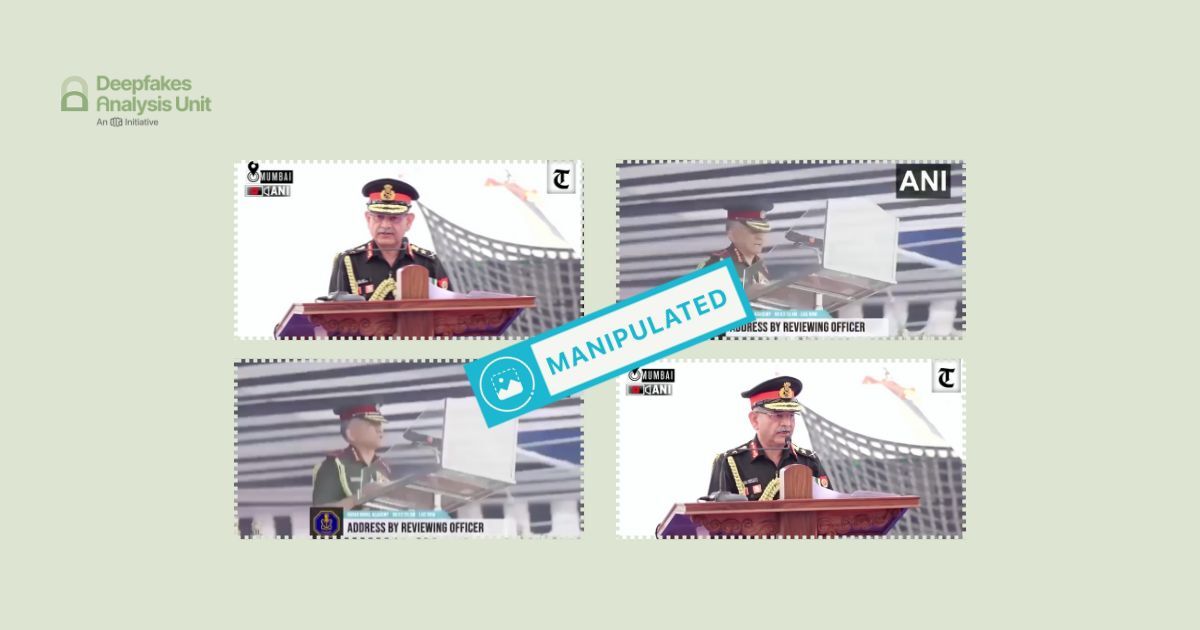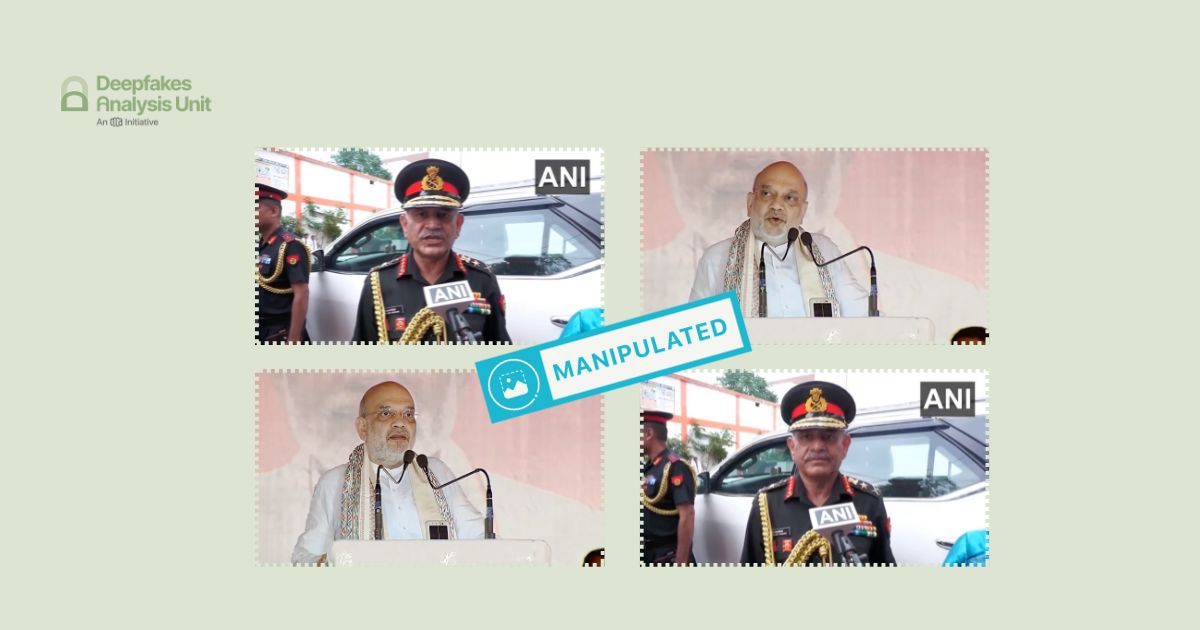Updated on July 21, 2025: The Deepfakes Analysis Unit updated the report with additional expert inputs.
The Deepfakes Analysis Unit (DAU) analysed a video which apparently shows that Dr. Subrahmanyam Jaishankar, India’s External Affairs Minister, supposedly made a public statement about India losing three Rafale aircraft to Pakistan. After putting the video through A.I. detection tools and getting our expert partners to weigh in, we were able to conclude that an A.I.-generated audio clip was spliced with his real audio to manipulate the video.
A Facebook link to the 22-second video in English was escalated to the DAU by a fact-checking partner for analysis. The video, embedded in a post, was published on July 3, 2025 from an account with the display name of “Jamshaid Iqbal”, and a display picture of two men standing beside each other. The profile details mention that the account belongs to a “digital creator” based in Pakistan.
We do not have any evidence to suggest that the video originated from the aforementioned account or another. The same video was also published from other Facebook accounts and surfaced on many profiles on the microblogging site, X, formerly Twitter.
The post that carries the video also has accompanying text in English which reads: “Breaking: India’s Ministry of External Affairs confirms loss of 3 Rafale jets and other aircraft after Pakistani strike. AI?” And below that the same text appears in Urdu. In both sets of messages emojis of a beacon, and the national flags of India and Pakistan are placed with the text.
In the video, Dr. Jaishankar is captured in a wide shot, seated on a chair. He seems to be addressing a gathering as he holds a microphone in one hand, gestures in an animated manner with the other, and his gaze keeps shifting in different directions along with his head.
The backs of the heads of two people are visible in the foreground and two glasses filled with water are placed on the table beside Jaishankar. The perspective of the video looks a bit odd as the video frame seems to have been edited rather roughly, cutting a portion of the glass apparently placed for a second person not visible in the frame. A massive glass panel in the backdrop offers a blurry view of a skyline.
The video quality is rather poor with Jaishankar’s face heavily pixelated, making it difficult to perfectly decipher the extent of synchronisation between the audio and his lip movements. However, the lip-sync seems fine in some parts while in others it doesn’t, and his lips also appear to move unnaturally fast at multiple instances.
His teeth appear blurry with only the lower set visible throughout the video. In some frames, the lower set looks like a shiny white patch. His nose appears to oddly crinkle in a few frames and his face seems to twitch in one frame toward the end of the video track.
On comparing the voice attributed to Jaishankar in the video with his recorded speeches and interviews available online, the striking similarity in tone, diction, accent as well as his characteristic mellow tone, are hard to miss. However, there’s a nine-second segment in the middle of the video in which the audio has a peculiar echo, which is not heard anywhere else in the video. In that particular segment there is a slight variation in the tone and pitch, and the delivery sounds unnaturally monotonous and scripted.
We undertook a reverse image search using screenshots from the video and traced Jaishankar’s clip to this video published on July 1, 2025 from the official YouTube channel of the India’s Ministry of External Affairs.
His clothing is identical in the video we reviewed and the one we were able to trace. However, the background and foreground look slightly different in the two videos as the frames used in the manipulated version are more zoomed-in with portions of the foreground and background cropped out.
The source video is also in English and it features an interviewer but his visuals have been edited out from the clip used to create the doctored video. Most of the audio heard in the doctored video has been taken from the original video. There is only a small portion, which is different; we would like to mention that it is that very nine-second segment which we pointed to above as having an echo sound.
When we compared the video portions from the original video which have seemingly been used in the manipulated video, we observed that the hand gestures of Jaishankar look slightly different in the two videos. The manipulated video track does not have any visible jump cuts or transitions and looks fairly seamless. It appears that a 22-second chunk of the video track has been lifted from the source video and it has been synced with an audio track produced by stitching together portions of the original audio track and a small synthetic audio track.
We have consistently been highlighting the common patterns or seemingly emerging trends in the audio and video content manipulated or generated using A.I. through our assessment reports. We have shared below a table that compares the audio tracks from the original video featuring Jaishankar and the manipulated one. By no means do we want to give any oxygen to the bad actors behind this misleading and harmful video. Instead, we want to inform our readers about how a certain narrative has been fabricated using synthetic audio.

In most videos debunked by the DAU we have seen a trend where a synthetic audio track is used with an original video track to create a fake video. There have only been a few examples of the kind that we are addressing through this report, such as here and here, where A.I.-generated words have been added to an original audio track.
To discern the extent of A.I. manipulation in the video under review, we put it through A.I. detection tools.
The voice tool of Hiya, a company that specialises in artificial intelligence solutions for voice safety, indicated that there is only a seven percent probability of the audio track in the video having been generated or modified using A.I.

Hive AI’s deepfake video detection tool highlighted several markers of A.I. manipulation in the video track. However, their audio detection tool did not indicate that any parts of the audio track were A.I.-generated.

We also ran the audio track through the A.I. speech classifier of ElevenLabs, a company specialising in voice A.I. research and deployment. The results that returned indicated that it was “very unlikely” that the audio track used in the video was generated using their platform.
However, when we reached out to ElevenLabs for a comment on the analysis they told us that based on technical signals analysed by them they were able to confirm that the audio track in the video is synthetic or A.I.-generated. They added that they have taken action against the individuals who misused their tools to hold them accountable.
To get another expert to weigh in on the video, we escalated it to the Global Deepfake Detection System (GODDS), a detection system set up by Northwestern University’s Security & AI Lab (NSAIL). The video was analysed by two human analysts, run through 22 deepfake detection algorithms for video analysis, and seven deepfake detection algorithms for audio analysis.
Of the 22 predictive models, 13 gave a higher probability of the video being fake and the remaining nine gave a lower probability of the video being fake. Five of the seven predictive models gave a high confidence score to the audio being fake and the remaining two models gave a low confidence score to the audio being fake.
In their report, the team echoed our observations about the inconsistent lip-sync. They pointed to a six-second-segment in the video where Jaishankar’s head appears to move abruptly in contrast with the fluidity of natural human motion. They also mentioned that his glasses and teeth disappear and reappear throughout the video, especially in the segment, which carries the A.I.-generated audio that we pointed to above.
The GOODS’ team also pointed to specific time codes in the video where the microphone appears close to Jaishankar’s shirt collar and its structure warps and seemingly merges into the collar. In conclusion, the team stated that the video is likely generated via artificial intelligence.
We further escalated the video to our partner GetReal Security, co-founded by Dr. Hany Farid and his team, they specialise in digital forensics and A.I. detection. They stated that a signal from their audio analysis models suggested that the eight-second audio segment in the video between the six and 14-second mark may have been synthesised.
Their audio experts clearly noticed that the middle of the video has a very distinct change in the reverberation characteristics with no visual change in the position of the microphone or of the configuration of the room. They added that, while it is possible that someone decided to switch the audio source to a more distant microphone for that segment, it is very unlikely and highly suspicious.
On the basis of our findings and expert analyses, we can conclude that synthetic audio was added to Jaishankar’s real audio to peddle a false narrative about India losing a certain number of combat aircraft in the recent India-Pakistan conflict.
(Written by Debraj Sarkar and Debopriya Bhattacharya, edited by Pamposh Raina.)
Kindly Note: The manipulated audio/video files that we receive on our tipline are not embedded in our assessment reports because we do not intend to contribute to their virality.
You can read below the fact-checks related to this piece published by our partners:
No, EAM S Jaishankar Did Not Say India Lost Rafale Jets to Pakistan
This viral video of S. Jaishankar saying that India lost three Rafale jets to Pakistan is edited
Fact Check: No, S Jaishankar DID NOT admit to losing Rafales to Pakistan
Video Of S Jaishankar Admitting Loss Of 3 Rafale Jets Is Manipulated
Fact Check: Jaishankar Did Not Say That 3 Indian Rafale Jets Were Shot Down; Video Is AI-Manipulated












